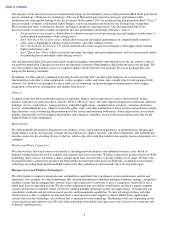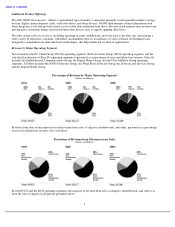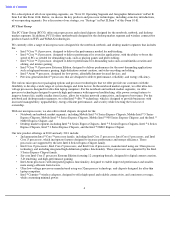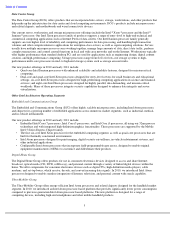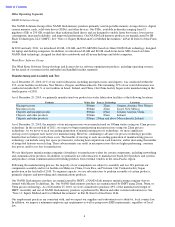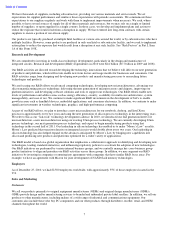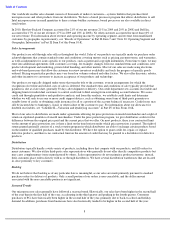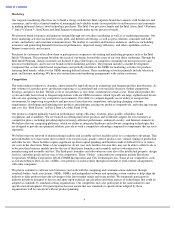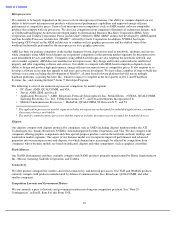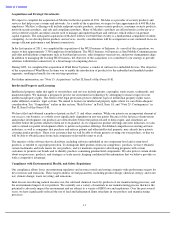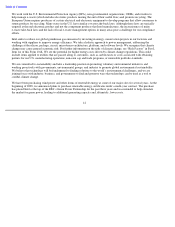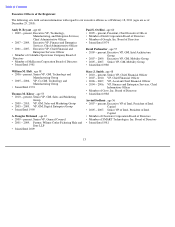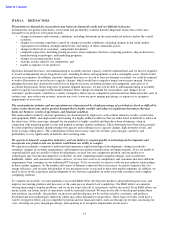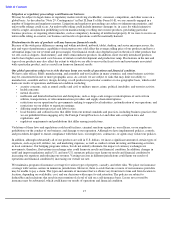Intel 2010 Annual Report Download - page 17
Download and view the complete annual report
Please find page 17 of the 2010 Intel annual report below. You can navigate through the pages in the report by either clicking on the pages listed below, or by using the keyword search tool below to find specific information within the annual report.
Table of Contents
Our worldwide reseller sales channel consists of thousands of indirect customers—systems builders that purchase Intel
microprocessors and other products from our distributors. We have a boxed processor program that allows distributors to sell
Intel microprocessors in small quantities to these systems-builder customers; boxed processors are also available in direct
retail outlets.
In 2010, Hewlett-Packard Company accounted for 21% of our net revenue (21% in 2009 and 20% in 2008) and Dell Inc.
accounted for 17% of our net revenue (17% in 2009 and 18% in 2008). No other customer accounted for more than 10% of
our net revenue. For information about revenue and operating income by operating segment, and revenue from unaffiliated
customers by geographic region/country, see “Results of Operations” in Part II, Item 7 and “Note 30: Operating Segment and
Geographic Information” in Part II, Item 8 of this Form 10-K.
Sales Arrangements
Our products are sold through sales offices throughout the world. Sales of our products are typically made via purchase order
acknowledgments that contain standard terms and conditions covering matters such as pricing, payment terms, and warranties,
as well as indemnities for issues specific to our products, such as patent and copyright indemnities. From time to time, we may
enter into additional agreements with customers covering, for example, changes from our standard terms and conditions, new
product development and marketing, private-label branding, and other matters. Most of our sales are made using electronic
and web-based processes that allow the customer to review inventory availability and track the progress of specific goods
ordered. Pricing on particular products may vary based on volumes ordered and other factors. We also offer discounts, rebates,
and other incentives to customers to increase acceptance of our products and technology.
Our products are typically shipped under terms that transfer title to the customer, even in arrangements for which the
recognition of revenue and related costs of sales is deferred. Our standard terms and conditions of sale typically provide that
payment is due at a later date, generally 30 days after shipment or delivery. Our credit department sets accounts receivable and
shipping limits for individual customers to control credit risk to Intel arising from outstanding account balances. We assess
credit risk through quantitative and qualitative analysis, and from this analysis, we establish credit limits and determine
whether we will seek to use one or more credit support devices, such as obtaining some form of third-party guarantee or
standby letter of credit, or obtaining credit insurance for all or a portion of the account balance if necessary. Credit losses may
still be incurred due to bankruptcy, fraud, or other failure of the customer to pay. For information about our allowance for
doubtful receivables, see “Schedule II—Valuation and Qualifying Accounts” in Part IV of this Form 10-K.
Most of our sales to distributors are made under agreements allowing for price protection on unsold merchandise and a right of
return on stipulated quantities of unsold merchandise. Under the price protection program, we give distributors credits for the
difference between the original price paid and the current price that we offer. On most products, there is no contractual limit
on the amount of price protection, nor is there a limit on the time horizon under which price protection is granted. The right of
return granted generally consists of a stock rotation program in which distributors are able to exchange certain products based
on the number of qualified purchases made by the distributor. We have the option to grant credit for, repair, or replace
defective products, and there is no contractual limit on the amount of credit that may be granted to a distributor for defective
products.
Distribution
Distributors typically handle a wide variety of products, including those that compete with our products, and fill orders for
many customers. We also utilize third-party sales representatives who generally do not offer directly competitive products but
may carry complementary items manufactured by others. Sales representatives do not maintain a product inventory; instead,
their customers place orders directly with us or through distributors. We have several distribution warehouses that are located
in close proximity to key customers.
Backlog
We do not believe that backlog as of any particular date is meaningful, as our sales are made primarily pursuant to standard
purchase orders for delivery of products. Only a small portion of our orders is non-cancelable, and the dollar amount
associated with the non-cancelable portion is not significant.
Seasonal Trends
Our microprocessor sales generally have followed a seasonal trend. Historically, our sales have been higher in the second half
of the year than in the first half of the year, accelerating in the third quarter and peaking in the fourth quarter. Consumer
purchases of PCs have historically been higher in the second half of the year, primarily due to back-to-school and holiday
demand. In addition, purchases from businesses have also historically tended to be higher in the second half of the year.
8



